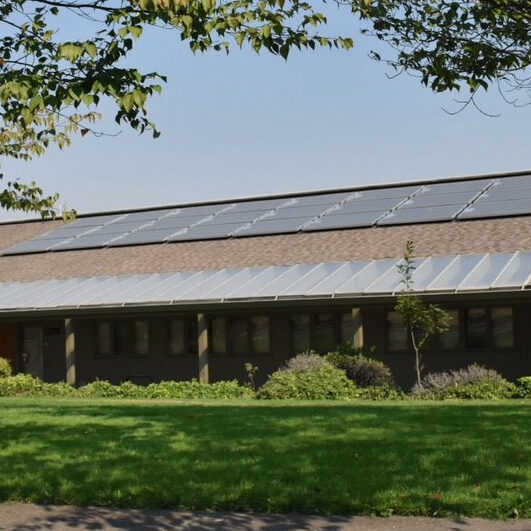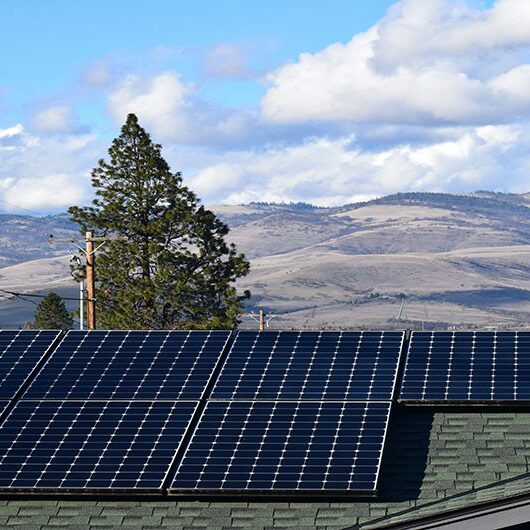Ashland, Oregon
Renewable Energy
The City of Ashland supports clean local renewable energy production.

Overview
Is my site good for solar?
There are many factors to determine if your property is a good candidate for solar. Assessing your roof is a good place to start. You will need to determine how much sunlight your roof receives. A south facing roof with access to direct sunlight for a majority of the day is the ideal condition. The size of your roof will also determine how many panels you can fit and if that will be enough to support your energy usage. It is also important to determine the longevity of your roof - you don't want to have to replace it once solar panels are already installed. Every house is a unique situation so it's best to reach out to your local installer.
Additional resources
- Use our GIS map to see your solar potential
- Find local installers
- Solar Oregon

Overview
Solar Electric (PV) Incentives
To encourage Ashland residents and businesses to install new solar electric systems interconnected with the electrical supply grid, the City of Ashland offers financial incentives for qualifying installations.
Current incentives:
- Beginning January 1, 2023
- Solar electric installations that pass their electric inspections can receive incentive payments of $600 from the City of Ashland.
- Before January 1, 2023
- Cash incentive for interconnected solar electric systems of $0.25 per watt for residential and commercial use systems, to a maximum of $5,000 per individual system. Systems will need to verify a total solar resource fraction (TSRF) of at least 75%.
To qualify:
- The owner of the system must own or be a tenant of the facility where the system is installed.
- The system must be interconnected with the electric service at the facility and be net-metered.
- The system must have at least 2,500 W of panels with total solar resource fractions (TSRFs) of at least 75%.
- Qualifying systems must have at least 2,500 Watts of panels with TSRFs of at least 75% that are independent (independent maximum power point tracking) from panels with less than 75% TSRFs.
- The system must be installed with permits from the City's Building Safety Division and comply with all permit requirements.
- Ensure that you have read all program details and understand all program eligibility requirements. (Please contact staff early in the process if you have questions.)
- Download and complete the following documents:
- Upload completed and signed documents through our online form.
- Send a roof plan with corresponding TSRFs of each panel.
- Send a copy of the project invoice.
Questions? Contact Larry Giardina - giardin@ashland.or.us / 541-552-2065
- Why will the solar incentive change on January 1, 2023?
- Due to robust installations of solar systems in Ashland, the City has expended our entire solar incentive budget for two years in the first year of our biannual budget period. The larger solar incentives offered by Ashland than by other utilities in Oregon have resulted in increased installations by solar contractors from all areas of the state and out of state. To extend the availability of solar incentives we need to supplement our solar budget and adjust solar incentives to be more in line with other utilities.
- Why did the solar incentive change on July 1st, 2021?
- From the first solar installation in 2001 the City has provided financial incentives for installations and net metering to foster solar electric generation and help develop it as an emerging technology. Often as this technology matures, incentive amounts decrease. There are a variety of other factors involved in the incentive reductions for the solar program, including increased emphasis on electrification through additional programs for reductions of fossil fuel use in the community, social equity across our program offerings as mandated in the City’s Climate and Energy Action Plan (CEAP) and continued efficiencies in staff costs associated with program administration.
- What does a program update look like?
- Utility staff will review the solar program each January with any proposed changes communicated by February 1 for solar partner input/dialogue. Final decisions will be made by March 1 of each year with a June 1 implementation.
- Are there any other rebates available for solar?
- The State of Oregon has a Solar + Storage rebate program. They issue rebates for solar electric systems and paired solar and solar storage systems for residential customers and low-income service providers in Oregon. For the most up-to-date information, check their website.

Program Overview
Off-Site Solar
Ashland has a quality solar resource, but with rugged terrain and a mature tree canopy only 50% of buildings are well suited for solar energy systems. Off-site solar allows systems to be installed anywhere within the City's electric grid. This enables systems to be sized and suited for optimal performance and improved investment. The energy produced at one electric meter is credited to another meter within Ashland's Municipal Electric Utility. Having the system off-site also allows citizens to support renewable energy without having to modify their building or residence.
Examples
- Community solar projects: groups of residents or businesses may share in the production of a combined solar installation.
- Leasing opportunities: Owners of large rooftops or other under-utilized space may profit from leasing that area for solar development.
Off-site solar is privately owned and is meant to be developed in much of the same way as conventional solar. The primary difference is that the City of Ashland facilitates the billing mechanism which transfers energy credits from the generator to the recipient. The City does not define the relationship between the project developer/owner, project site owner, and energy credit recipient.
Off-site solar participants may pursue a variety of ownership models, including direct ownership, group ownership, long term power contracts, and subscription models, to name a few possibilities. The owner of the system is responsible for finding an installation site.
Additional details
- Each "generator account" must fill out an allocation table (updated once per year) describing how and where the energy will be distributed (on a percent basis).
- Each "benefitting account" receives a kWh credit for each kWh produced by the generator account on their behalf.
- The program is only available within the Ashland Municipal Electric Utility.
Read the Net Metering Resolution for more information.
There are a few off-site solar examples that are happening around Ashland.

Overview
Carbon Offsets & REC's
Bonneville Environmental Foundation (BEF) provides a tool for Ashland residents and businesses to participate in reducing greenhouse gas emissions through the purchase of carbon offsets or renewable energy credits (REC's).
Renewable energy credits ensure that you are getting the environmental benefits of clean energy. Carbon offsets reduce greenhouse gas emissions from other activities, such as vehicle travel or natural gas use.
Calculate your carbon footprint to identify ways you can make adjustments in your daily routine and see if there is a place for you to purchase carbon offsets or REC's.
You can purchase carbon offsets or REC's through Bonneville Environmental Foundation's website.
- What exactly are carbon offsets?
- Carbon offsets (also called carbon credits) are generated by discrete carbon reduction projects. One carbon offset represents the reduction of 1 metric ton (or 2,205 pounds) of greenhouse gas emissions that occur as a result of that specific project.
- 1 carbon offsets = 1 metric ton of CO2e kept from the atmosphere
- How much is one carbon offset?
- Carbon offsets purchased through BEF are $10.00 per metric ton.
Source: BEF
Contact Us For Information
Use the form below to ask questions about our climate and energy programs.
"*" indicates required fields